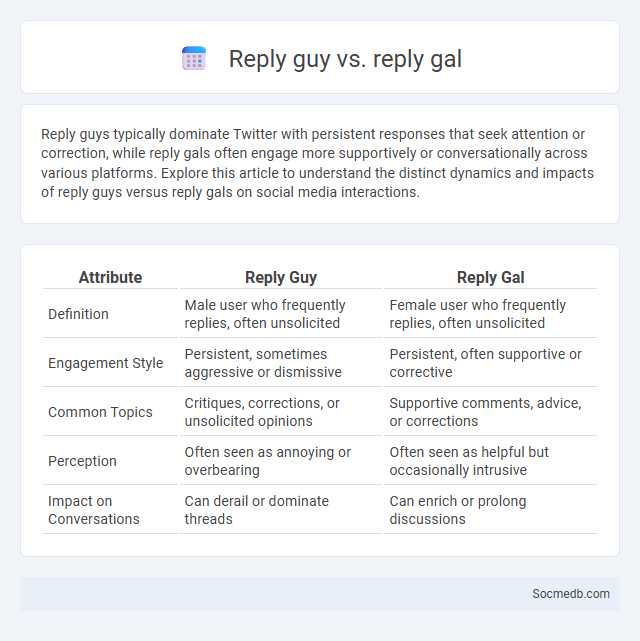
Photo illustration: Reply guy vs reply gal
Reply guys typically dominate Twitter with persistent responses that seek attention or correction, while reply gals often engage more supportively or conversationally across various platforms. Explore this article to understand the distinct dynamics and impacts of reply guys versus reply gals on social media interactions.
Table of Comparison
| Attribute | Reply Guy | Reply Gal |
|---|---|---|
| Definition | Male user who frequently replies, often unsolicited | Female user who frequently replies, often unsolicited |
| Engagement Style | Persistent, sometimes aggressive or dismissive | Persistent, often supportive or corrective |
| Common Topics | Critiques, corrections, or unsolicited opinions | Supportive comments, advice, or corrections |
| Perception | Often seen as annoying or overbearing | Often seen as helpful but occasionally intrusive |
| Impact on Conversations | Can derail or dominate threads | Can enrich or prolong discussions |
Understanding the "Reply Guy" Phenomenon
The "Reply Guy" phenomenon refers to individuals, typically men, who frequently respond to women's social media posts with unsolicited advice, critiques, or attempts to assert expertise, often leading to perceived overreach or annoyance. This behavior highlights broader issues of online gender dynamics and digital communication patterns where certain users seek attention or validation through persistent engagement. Understanding this trend helps in recognizing social media's complex interactional norms and fostering healthier online discourse.
Who or What is a "Reply Gal"?
A "Reply Gal" is a social media user known for actively engaging with posts by consistently replying to trending topics, often adding humor, insights, or personal commentary. These users build a dedicated following by shaping conversations through prompt and relatable responses. Your interaction with a Reply Gal can spark dynamic discussions and increase visibility within online communities.
Origins and Evolution of Internet Reply Culture
Internet reply culture originated from early online forums and newsgroups in the 1980s and 1990s, where users engaged in threaded discussions and direct responses. The evolution accelerated with the rise of social media platforms like Twitter, Facebook, and Reddit, which introduced real-time interactions and diverse multimedia replies. Advanced algorithms now personalize and prioritize replies, shaping user engagement and digital communication dynamics.
Distinguishing Traits: Reply Guy vs. Reply Gal
Reply Guy often exhibits assertive and knowledgeable commentary, frequently engaging in male-centric discussions or attempting to correct others' opinions, while Reply Gal tends to showcase empathetic and community-oriented responses, emphasizing support and positivity. Both Reply Guy and Reply Gal are characterized by persistent interaction patterns on social media threads, but their distinct tones and approaches reflect gendered communication styles that influence online dynamics. Understanding these differences can help you navigate and interpret social media conversations more effectively.
Motivations Behind the Replies: Gender Perspectives
The motivations behind social media replies often differ significantly between genders, with women more likely to engage in supportive and empathetic responses, while men tend to prioritize informational or argumentative interactions. Studies reveal that female users frequently seek social connection and validation, whereas male users often focus on status affirmation and knowledge exchange. Understanding these gender-based communication patterns enhances targeted strategies for content engagement and community building on social media platforms.
Social Dynamics in Online Conversations
Social dynamics in online conversations shape user interactions through norms, roles, and power structures within digital communities. Algorithms influence visibility and engagement, affecting how opinions spread and group identities form on platforms like Twitter and Facebook. Understanding these patterns helps optimize social media strategies for fostering meaningful dialogue and managing online behavior.
Stereotypes and Misconceptions
Social media often perpetuates stereotypes and misconceptions by amplifying selective narratives and reinforcing biased views through algorithms favoring sensational content. Your critical consumption of diverse sources and fact-checking can counteract these distortions, promoting a more accurate and inclusive understanding of complex issues. Recognizing how stereotypes influence online interactions helps reduce prejudice and fosters healthier digital communities.
Impact on Online Discourse and Engagement
Social media dramatically reshapes online discourse by amplifying diverse voices and accelerating information exchange, which enhances Your ability to connect with global audiences instantly. Algorithms prioritize engaging content, often intensifying echo chambers and polarizing debates, influencing public opinion and social dynamics. Metrics like shares, comments, and likes serve as critical indicators of engagement, guiding content strategies and fostering active community participation.
Navigating and Responding to Reply Culture
Reply culture on social media shapes online conversations by encouraging rapid, often reactive responses that can amplify misunderstandings or fuel conflicts. Navigating this environment requires users to practice mindful communication, valuing thoughtful engagement over impulsive replies to foster constructive dialogue. Employing strategies such as pausing before responding and prioritizing clarity helps mitigate the negative impact of reply culture and promotes more meaningful interactions.
The Future of Reply Interactions on Social Media
Reply interactions on social media are evolving with advancements in AI-driven sentiment analysis and context-aware responses, enabling more personalized and meaningful conversations. Platforms are integrating features like threaded replies and real-time translation to enhance user engagement and foster global connectivity. Your social media experience will become more interactive, intuitive, and tailored to your communication style.
 socmedb.com
socmedb.com